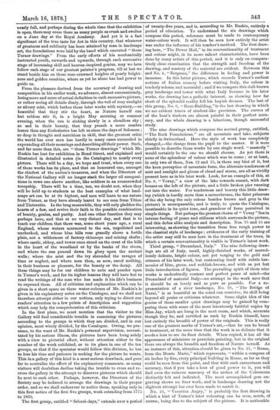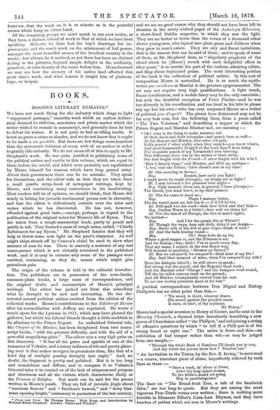ART.
"THOSE TURNER DRAWINGS."
[FIRST NOTICE.]
AT the Fine-Art Society's Galleries, 148 New Bond Street, may now be seen daily a collection of pictures chiefly referred to in- society and by the publicgenerally by the above title. Occasionally the little room, which holds comfortably, say, thirty people,:in
nearly full, and perhaps during the whole time that the exhibition is open, there may come there as many people as crush and swelter on a June day at the Royal Academy. And yet it is a fact significant of the true taste for Art in this country, that whatever of greatness and sublimity has been attained by man in landscape -art, the foundations were laid by the hand which executed "those Turner drawings." From the early efforts of his mechanically instructed youth, onwards and upwards, through each successive stage of increasing skill and heaven-inspired genius, may we here follow each stage of our greatest painter's progress, till at last we stand beside him on those rose-crowned heights of pearly bright- ness and golden sunshine, where as yet he alone has had power to guide us.
From the pleasure derived from the accuracy of drawing and composition in his earlier work, we advance, almost unconsciously, losing more and more of actual definition in each successive picture, or rather seeing all details dimly, through the veil of rosy sunlight or silvery mist, which bathes these later works with mystery,—so beautiful that they stir the heart, as Nature herself can but seldom stir it, in a bright May morning or summer evening, when the sun is sinking slowly in a cloudless sky ; so sad in their beauty, that they preach a more sombre lesson than any Ecclesiastes has left us since the days of Solomon ; so deep in thought and matchless in skill, that the greatest critic the world has ever seen has hardly in many cases succeeded in expounding all their meanings and describing all their power. Such, and far more than this, are "those Turner drawings" which Mr. Ruskin has lent for exhibition in Bond Street, and explained and 'illustrated in detailed notes (in the Catalogue) to nearly every picture. There will be a day, we hope and trust, when every one of these works has its place, and that an honoured one, amongst the chiefest of the nation's treasures, and when the Directors of -the National Gallery will no. longer stack the larger oil composi- tions in rows one above another, like soldiers in an overcrowded troopship. There will be a time, too, we doubt not, when they -will be held up to students as the best examples of what land- scape art can be at its highest, and men will learn to see nature from Turner, as they have already learnt to see man from Titian and Tintoretto. In the long meanwhile, they will only gladden the hearts of a few, and revive their faith in the possible combination of beauty, genius, and purity. And one other function they may perhaps have, and that at no very distant day, and that is to teach our children that there was, some short years ago, a rural England, whose waters murmured to the sea, unpolluted and unchecked, and whose blue hills rose grandly above a fertile plain, not a wilderness of factory chimneys and mining shafts ; -where castle, abbey, and tower once stood on the crest of the hills in the heart of the woodland or by the banks of the rivers, and where the sun poured down its glory upon the ancient walls ; where the mist and the ivy shrouded the ravages of -time or neglect, and where men then, as now, cared nothing, in their business or pleasure, for the beauty or the decay. All these things may be for ow children to note and ponder upon in Turner's work, and for its higher lessons they will have but to read the writings of the man who has made it his life's business -to expound them. All of criticism and explanation which can be
given in a short space on these water-colours of Mr. Ruskin's is given in his explanatory notes on the Catalogue, and we shall not therefore attempt either in our notices, only trying to direct our readers' attention to a few points of description and suggestion -which may help the comprehension of this criticism.
In the first place, we must mention that the visitor to the 'Gallery will find considerable trouble in examining the pictures according to the groups in which they are divided, and in our opinion, most wisely divided, by-the Catalogue. Owing, we pre- sume, to the want of Mr. Ruskin's personal supervision, necessi- tated by his serious illness, the pictures have been hung solely with a view to pictorial effect, without attention either to the number of the work exhibited, or to its place in one of the ten groups, so that if the spectator would follow this division, be has to lose his time and patience in seeking for the picture he wants. This in a gallery of this kind is a most serious drawback, and goes far to neutralise the effect of the explanatory comments, as many visitors will doubtless decline taking the trouble to cross and re- cross the gallery in the attempt to discover pictures which should be next to each other. Perhaps, however, the Directors of the Society may be induced to arrange the drawings in their proper -order, and so we shall endeavour to notice them, speaking only in this first notice of the first five groups, work extending from 1775 to 1830.
The first group, entitled "School-days," extends over a period of twenty-five years, and is, according to Mr. Ruskin, entirely a period of education. To understand the six drawings which compose this period, reference must be made to contemporary water-colour work. It will then be seen how entirely the artist was under the influence of his teacher's method. The first draw- ing here, "The Dover Mail," in its conventionality of treatment and colour might, in its more salient characteristics, have been done by many artists of this period, and it is only on compara- tively close examination that the strength and freedom of the drawing, and mastery of the material are evident. Between this and No. 4, "Bergamo," the difference in feeling and power is immense. In this latter picture, which records Turner's earliest notions of Italian scenery before visiting Italy, the colour is tenderly solemn and mournful ; and if we compare this dull-brown grey landscape and tower with what Italy became in his later works, the drawing has a pathetic interest, as showing how far short of the splendid reality fell his boyish dreams. The last of this group, No. 6, "Boat-Building," is the last drawing in which we see evident traces of student-like precision. The curves of of the boat's timbers are almost painful in their perfect accu- racy, and the whole drawing is a laborious, though successful study.
The nine drawings which compose the second group, entitled, "The Rock Foundations," are all mountain and lake, subjects chiefly in Switzerland. Here the style of work has completely changed,—the change from the pupil to the master. If it were possible to describe these works by one single word, " masterly " would certainly be the one we should choose. As yet there is none of the splendour of colour which was to come ; or at least, in only two of them, Nos. 12 and 15, is there any hint of it, but the keen perception of mountain form, the alternate tenderness of mist and sunlight and gloom of cloud and storm, are all as vividly present here as in his later work. Look, for an example of this, at No. 8, " Vevay," a view of the lake towards sunset, with dark houses on the left of the picture, and a little broken pier running out into the water. For tenderness and beauty this little draw- ing (which is hardly more than a monochrome, the faint primrose of the sky being the only colour besides brown and grey in the picture) is unsurpassable, and is truly, to quote the Catalogue, inestimable in its quiet tone, and grandeur of form perceived in simple things. But perhaps the greatest charm of " Vevay " lies in intense feeling of peace and stillness which surrounds the picture, and this defies alike analysis and description. Nos. 13 and 15 are interesting, as showing the transition from free rough power to the classical style of landscape ; evidences of the early training of the artist may still be seen here in the treatment of the trees, in which a certain conventionality is visible in Turner's latest work. Third group, "Dreamland, Italy." The nine following draw- ings are all of Italy, small, highly-finished works, of marvel- lously delicate, bright colour, not yet verging to the gold and crimson of his later work, but contenting itself with subtle har- monies of blue, green, and reddish-brown, and with as yet but little introduction of figures. The prevailing spirit of these nine works is undoubtedly content and perfect peace of mind—the Dreamland of material Italy—no attempt in the work save that it should be as lovely and as pure as possible. For a re- presentation of a river landscape, No. 19, "The Bridge of Narni," is as beautiful as the mind can conceive, its skill being beyond all praise or criticism whatever. Some slight idea of the genius of these smaller quiet drawings may be gained by com- paring them with some of the most laboriously faithful copies by Miss Jay, which are hung in the next room, and which, accurate though they be, and certified as such by Ruskin himself, have lost entirely the breadth of power of the originals. This is really one of the greatest marks of Turner's art,—that he can be broad in treatment, at the same time that the work is so delicate that it needs a lens to see its finer details. When copied, it has all the appearance of miniature or porcelain painting, but in the original there are always the breadth and freedom of Nature herself. As an instance of this, attention should be given to No. 21, "Rome, from the Monte Mario," which represents, "within a compass of six inches by five, every principal building in Rome, as far as they could be seen from this point, and that with such earnestness and accuracy, that if you take a lens of good power to it, you will find even the ruinous masonry of the arches of the Colosseum distinctly felt and indicated. The most accomplished gem en- graving shows no finer work, and in landscape drawing not the slightest attempt has ever been made to match it.
No. 24, "Vesuvius Angry," is probably the first drawing in which a hint of Turner's later colouring can be seen, much, of course, being due to the subject of the picture. It is noticeable however, that the work on it is as minute as in the peaceful scenes which hang on either hand.
Of the remaining groups we must speak in our next notice, as they form a distinct school of work to that of which we have been speaking. Hitherto we have had the boy's drawings for im- provement, and the man's work on the attainment of full power, amongst the most beautiful scenes of the loveliest country in the world ; but always, be it noticed, as yet there has been no distinct feeling in the pictures, beyond simple delight in the sublimity, grandeur, or calm beauty of the scene before him. Henceforward we may see how the scenery of his native land affected this great man's work, and what lessons it taught him of gladness, hope, or despair.




































 Previous page
Previous page